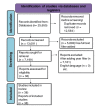Nephrotic Syndrome: A Review
- PMID: 38465146
- PMCID: PMC10924861
- DOI: 10.7759/cureus.53923
Nephrotic Syndrome: A Review
Abstract
Nephrotic syndrome (NS) is characterized by hypoalbuminemia, severe proteinuria, and peripheral edema, frequently in conjunction with hyperlipidemia. Individuals usually show symptoms of weariness and swelling, but no signs of serious liver damage or cardiac failure. With characteristic medical symptoms and evidence of hypoalbuminemia and severe proteinuria, NS can be diagnosed. The majority of NS episodes are classified as unexplained or primary; the most prevalent histopathological subgroups of primary NS in people are focal segmental glomerulosclerosis and membraneous nephropathy. Thrombosis of the veins with high cholesterol levels is a significant NS risk. Acute renal damage and infection are further possible side effects. The pathobiochemistry of NS involves alterations in genes that affect the selectivity of the kidneys and abnormalities in proteins related to podocytes. Understanding the molecular mechanisms that influence these processes is crucial to developing specific and targeted therapeutic approaches. The need for invasive renal biopsies throughout the diagnosis process may be lessened by the development of non-invasive nephrotic syndrome biomarkers, such as microRNAs. Corticosteroids are frequently used as the initial line of defense in NS treatment. However, some individuals need other treatments since a resistant type of NS also exists. The use of calcineurin inhibitors, mycophenolate mofetil, and rituximab is mentioned in the text, along with current research to identify safer and more efficient therapeutic choices. The complicated kidney condition NS has several underlying causes and symptoms. For the diagnosis of this ailment as well as the creation of focused therapies, an understanding of the pathophysiology and the identification of possible biomarkers are essential.
Keywords: deficiency; kidney; nephrotic syndrome; proteinuria; steroid sensitive.
Copyright © 2024, Verma et al.
Conflict of interest statement
The authors have declared that no competing interests exist.
Similar articles
-
Nephrotic syndrome: immunological mechanisms.J Biol Regul Homeost Agents. 2019 Sep-Oct;33(5 Suppl. 1):13-18. Special Issue: Focus on Pediatric Nephrology. J Biol Regul Homeost Agents. 2019. PMID: 31630708
-
Nephrotic Syndrome.Pediatr Rev. 2022 Feb 1;43(2):87-99. doi: 10.1542/pir.2020-001230. Pediatr Rev. 2022. PMID: 35102405
-
Exome Sequencing Revealed a Novel Splice Site Variant in the CRB2 Gene Underlying Nephrotic Syndrome.Medicina (Kaunas). 2022 Dec 4;58(12):1784. doi: 10.3390/medicina58121784. Medicina (Kaunas). 2022. PMID: 36556986 Free PMC article.
-
State of the art in childhood nephrotic syndrome: concrete discoveries and unmet needs.Front Immunol. 2023 Jul 12;14:1167741. doi: 10.3389/fimmu.2023.1167741. eCollection 2023. Front Immunol. 2023. PMID: 37503337 Free PMC article. Review.
-
Genetic basis of adult-onset nephrotic syndrome and focal segmental glomerulosclerosis.Front Med. 2017 Sep;11(3):333-339. doi: 10.1007/s11684-017-0564-1. Epub 2017 Aug 3. Front Med. 2017. PMID: 28776307 Review.
Cited by
-
Diffuse Large B-Cell Lymphoma With Membranous Proliferative Glomerulonephritis as the First Manifestation: A Case Report.Clin Case Rep. 2025 Apr 3;13(4):e70353. doi: 10.1002/ccr3.70353. eCollection 2025 Apr. Clin Case Rep. 2025. PMID: 40190356 Free PMC article.
-
Case Report: a novel variant in WT1 leads to focal segmental glomerulosclerosis and uterovaginal anomalies through exon skipping.Front Nephrol. 2025 Apr 1;5:1542475. doi: 10.3389/fneph.2025.1542475. eCollection 2025. Front Nephrol. 2025. PMID: 40235736 Free PMC article.
-
NPHS Mutations in Pediatric Patients with Congenital and Steroid-Resistant Nephrotic Syndrome.Int J Mol Sci. 2024 Nov 15;25(22):12275. doi: 10.3390/ijms252212275. Int J Mol Sci. 2024. PMID: 39596340 Free PMC article. Review.
-
Autoantibodies Targeting Vinculin Reveal Novel Insight into the Mechanisms of Autoimmune Podocytopathies.Research (Wash D C). 2025 Jun 3;8:0722. doi: 10.34133/research.0722. eCollection 2025. Research (Wash D C). 2025. PMID: 40463498 Free PMC article.
-
Clotting Without a Clue: A Case Report of Acute Pulmonary Thromboembolism as the Initial Presentation of Focal Segmental Glomerulosclerosis (FSGS)-Associated Nephrotic Syndrome Without Deep Vein Thrombosis.Cureus. 2025 Jul 19;17(7):e88336. doi: 10.7759/cureus.88336. eCollection 2025 Jul. Cureus. 2025. PMID: 40837927 Free PMC article.
References
-
- Nephrotic syndrome. Politano SA, Colbert GB, Hamiduzzaman N. Prim Care. 2020;47:597–613. - PubMed
-
- Kidney transplant: new opportunities and challenges. Augustine J. Cleve Clin J Med. 2018;85:138–144. - PubMed
-
- Idiopathic nephrotic syndrome in children. Noone DG, Iijima K, Parekh R. Lancet. 2018;392:61–74. - PubMed
-
- Congenital nephrotic syndrome. AbuMaziad AS, Abusaleh R, Bhati S. J Perinatol. 2021;41:2704–2712. - PubMed
-
- Pediatric nephrotic syndrome: pharmacologic and nutrition management. Hampson KJ, Gay ML, Band ME. Nutr Clin Pract. 2021;36:331–343. - PubMed
Publication types
LinkOut - more resources
Full Text Sources
Miscellaneous

